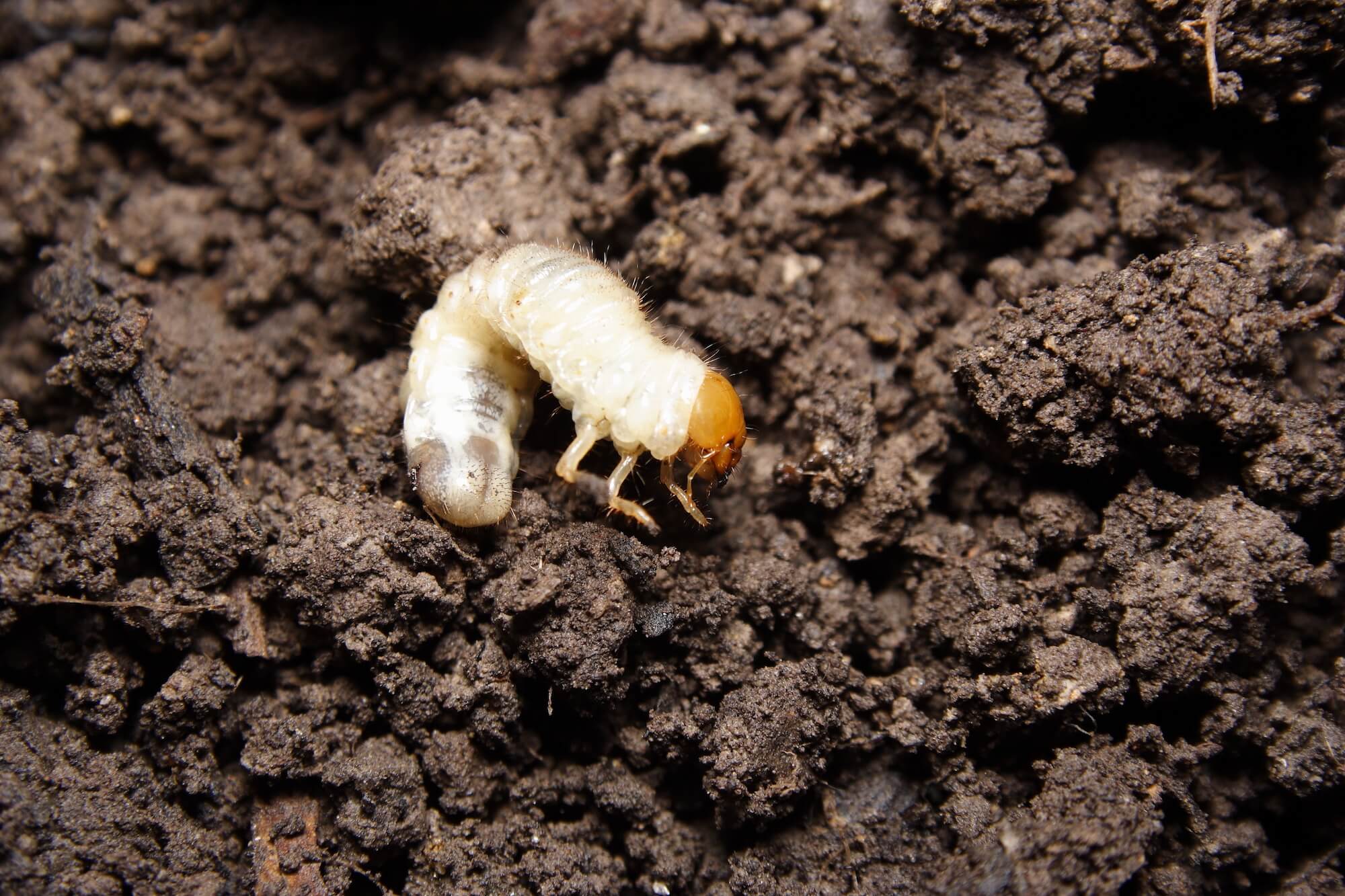Lawn Insect Management
If you spend some time in the great outdoors, you’re going to encounter bugs. Whether it’s ants at a picnic, mosquitoes biting at a barbecue, or a delicate ladybug on your fingertip, insects are all around us. In order to master lawn and garden care, it’s important to understand which insects are friends and which are foes.

Though garden bugs are commonly seen as annoying, some can be beneficial. Other lawn pests may be damaging to your landscape or even dangerous, requiring chemical or natural extermination measures.
In most cases, garden insects are not a threat to your lawn
Bugs exist as a safe, natural, and biological form of pest control. Gardeners, landscapers, and homeowners tending to their lawns can appreciate most garden insects for their true purpose—as beneficial, eco-friendly, and especially free pest control.
Granted, there will be times when you encounter destructive pests in your lawn, which we will cover in detail in this article. Knowing the difference between beneficial and destructive pests can preserve the delicate ecosystem in your yard and help your garden to thrive naturally.
Facts About Lawn Insects and Pests
Yes, most common insects are good for your lawn and garden. Insects can even be fascinating. Perhaps it’s time to explore these pesky pests further.
There are an estimated 10 quintillion insects living in the world.
It takes a honeybee approximately 10 million trips to gather enough nectar to yield a single pound of honey.
Rosebushes attract ladybugs, and a single ladybug can eat up to 50 aphids a day.
Praying mantises are considered good garden bugs, though they eat good and bad insects.
Stink bugs emit an odor to attract a potential mate.
Researchers believe that primitive grasshoppers existed even before dinosaurs.
Buzzing flies may be annoying, but they are actually beneficial bugs that can pollinate and eat other insects.
Spiders may cause phobias, but they are the best garden predators to have around.
Here are 10 of the most common insects found in gardens
- Aphids: Known to attack new plant growth and the underside of leaves.
- Caterpillars: Pest-type caterpillars may be found in gardens year-round but are most common in spring and fall.
- Fire Ants: Unpleasant garden guests that you never want to find at a picnic; fire ant colonies can grow up to 18 inches tall.
- Ground Beetles: Normally undetected, these bugs hide during the day and feed on slugs, maggots, larva, and snails.
- Grubs: June beetle or June bug larvae are called grubs; grubs are pests that often attack roots and grasses.
- Spiders: Considered a top garden insect to promote natural pest control; most outdoor garden spiders are not poisonous.
- Ladybugs: Beautiful and unique, these bugs feed on aphids and are attracted to pollen and flower nectar.
- Mosquitoes: Another unpopular garden pest found year-round in southern states; mosquitoes are most active from dusk to dawn.
- Honeybee: These buzzing bugs are essential to support plant pollination; honeybees are easily identified by the balls of yellow pollen carried on their legs.
- Worms: Essential for lawn and garden growth; also called brain worms, angle worms, earthworms, or nightcrawlers.
These 10 most common pests are just the tip of the iceberg when it comes to insects in your garden. On top of that, garden bugs will vary by region, climate, and season. Problematic garden pests like slugs are far more common in the Pacific Northwest, for example; you’re more likely to see aphids in the Southwest.
Now that you understand the importance of garden pests, it’s time to roll up your sleeves and get dirty. In the next section, we are going to discuss what you need to know about good and bad bugs in your backyard.
lawn insect
BENEFICIAL INSECT IPM CHART
![]()
Let’s start with the good news first:
Here are 10 beneficial bugs you want in your garden:
- Dragonflies: Dragonflies are beautiful to look at, and they also control the insect population by preying on midges, gnats, and mosquitoes.
- Ground Beetle: These predatory beetles support lawn and garden health by eating soil-dwelling pests, like maggots, snails, slugs, and cutworms.
- Honeybees: Honeybees are essential pollinators needed to support flowering plant life; honeybee activity is even more critical as declining populations threaten global agriculture.
- Hover Fly: Also called a flower fly, this fly looks like a small bee with a striped abdomen; flower flies are attracted to pollen and nectar and feed on aphidlarva.
- Hunting Wasps: Wasp species number in the hundreds, but hunting mini-wasps are beneficial as they attack eggs to control harmful insect populations.
- Lacewings: These beautiful, delicate insects are marked by their brown or pale green lacewings and feed primarily on nectar. Lacewings larva control pest population by preying on scales, aphids, mites, moth eggs, and small caterpillars.
- Ladybugs: Ladybugs are striking and attractive, with more than 400 species found in North America. Adult ladybugs and larva primarily feed on soft-bodied insects, like aphids—known to damage plants.
- Praying Mantis: Leaders in biological pest control, praying mantises are nocturnal hunters that feed on moths; moth larva can quickly destroy an entire plant.
- Spiders: Spiders are technically arachnids, not insects, but they are still classified as great garden bugs to have on your side. Spiders prey on small pests through delicately woven webs and funnels.
- Tachinid Fly: Before you swat at this “hairy housefly,” consider the fact that it preys on pesky caterpillars and beetles in the garden.
If you’re having a problem with garden or lawn growth these 10 bad bugs may be to blame
- Aphid: These bugs suck sap from plants and attack the underside of leaves—specifically, oaks, oleanders, pecans, roses, hibiscus, and vegetables.
- Cabbage Worms: Eggs laid on the underside of cabbage leaves hatch worms that eat unsightly holes in foliage.
- Caterpillars: Cute little caterpillars can also be problematic, like the tent caterpillar, the tomato hornworm, and the spring cankerworm known to damage plants.
- Colorado Potato Beetle: These bugs have been migrating west since the 1800s; the orange and black beetles can strip foliage on eggplant, tomato, and potato plants.
- Cucumber Beetles: Two types of Cucumber Beetles can wreak havoc on a garden by ravaging seedlings and transmitting bacterial wilt.
- Cutworms: Cutworms also fall into the “most hated” garden pest category as the worms cut down seedlings right at ground surface.
- Japanese Beetle: One of the most hated garden insects, an adult Japanese Beetle has the power to ravage plants in just a few hours.
- Leaf Miners: This group of bugs comes from the larva of different insects; eggs laid on leaves hatch, and larva “mine” inside foliage to damage delicate tissue.
- Snails/Slugs: Slippery, slimy snails and slugs attack flowers, stems, and leaves of plants; these pests have been known to demolish vegetable seedlings overnight.
- Spider Mites: These tiny bugs are surprisingly destructive and can eat plant sap to cause yellowing spots and leaves.
While some bad bugs have the power to undercut your best landscaping efforts, there are other pests in another category altogether. Dangerous bugs can bite and sting and may even be poisonous.
- Ants: Ants can be helpful to a garden by aiding in pollination and carrying soil; however, ants can bite and may cause an allergic reaction.
- Assassin Bugs: Just as the name suggests, these Arizona insects are highly dangerous and can inject lethal toxins that affect nerves, muscles, and other healthy tissue.
- Bees: Bumblebees and honeybees are stinging insects, though they are integral to lawn health; in those who are allergic, a bee sting can be life-threatening.
- Centipedes: These unique bugs are fun to look at, but make no mistake—brown or red centipedes can bite and inject venom into the skin.
- Chiggers: These mite larvae can be found in gardens, parks, and forests; chiggers are nearly microscopic and can leave red, itchy, raised bites on the skin.
- Fleas: Like mosquitoes, fleas are attracted to warm-blooded hosts and thrive in warm, damp environments. And like tick bites, flea bites can spread disease to family members and pets.
- Hornets/Wasps: Up to 100 people die annually from allergic reactions caused by wasp and bee stings. Hornets and wasps are naturally attracted to plants and flowers, so it’s important to use caution to coexist in the same outdoor space.
- Mosquitoes: Most often considered a garden nuisance, mosquitoes can be dangerous if they carry yellow fever, malaria, or West Nile Virus. Consider natural mosquito repellents for outdoor use, like apple cider vinegar and crushed parsley.
- Spiders: As we’ve already stated, most garden spiders are innocuous; still, there are a number of highly dangerous spider species to watch out for, including black widow, hobo, yellow sac, and brown recluse spiders.
- Ticks: Ticks are often carriers of Lyme disease and a number of other infections; ticks should be properly removed after a bite and taken to a doctor for analysis.
How to Manage and Treat Lawn Pests
In simplified categories of garden pests, there are the good, the bad, and the very bad. As a gardener or landscaper, you want to naturally cultivate the beneficial insects in your backyard ecosystem. This can help to naturally minimize harmful pests that feed on healthy plants.
Most horticulturists agree that the use of beneficial pests as pest control is far better than chemical pesticides.
Pesticides were first introduced for commercial use in the 1940s. After just a few decades of agricultural application, side effects were noticeable. Today, there are a number of regulations and restrictions on both commercial and residential pesticide use. Pesticides negatively affect the environment and can upset the natural insect predatory cycle, causing a rise in unwanted pest populations. Species of harmful insects can also grow pesticide-resistant.
Considering the fact that long-term pesticide use has been linked to health side effects, the choice is clear: Biological control through beneficial insects in the garden and eco-friendly pesticide alternatives are preferred to chemical pesticides, in most cases.
Simply put, you can minimize your use of pesticides by supporting beneficial insects in your garden.
The best way to protect good bugs is by avoiding toxic pesticide dusts and sprays. In many cases, pesticides kill the good with the bad. Support beneficial bugs in your backyard ecosystem by providing healthy flowers for pollen and nectar, fresh drinking water from a stream or birdbath, and shelter among plant mulch and a few weeds.
You can also use these helpful eco-friendly pesticide alternatives to keep bad bugs under control
- USE natural, non-toxic bug repellent outdoors, like cedar oil or apple cider vinegar and crushed parsley for mosquitoes.
- APPLY apple cider vinegar to pets after bathing for natural flea resistance.
- WASH visible bad bugs away, like aphids, using strong spray from a hose.
- SPRAY neem oil instead of pesticides on visible plant infestations.
- PLACE a shallow pie pan of beer around plants ravaged by slugs and snails; slugs are attracted to beer and will drown.
- TRIM trees and bushes away from your house to cut down on ant and termite infestation.
- COVER garbage cans to avoid attracting rodents and cockroaches.
- MAINTAIN your lawn to provide less edible plant matter for unwanted pests.
- HANG a bird feeder in your yard to welcome birds that feed on insects.
- PLANT insect-repellent plants, like marigolds, lemongrass, fennel, basil, thyme, and citronella.
SOURCES
“Beneficial Insects: Your Garden’s Most Powerful Allies.” Organic Gardening.
“Fascinating Bug Facts : HGTV Gardens.” HGTVGardens.
“The 10 ‘Most Wanted’ Bugs in Your Garden.” sjgov.org.
“Managing 10 Common Texas Yard Pests.” takecareoftexas.org.
“Dangerous Insects in Your Garden to Look Out For : HGTV Gardens.” HGTVGardens.
“Biological control.” ipm.ucdavis.edu.
“Beneficial Insect IPM Chart.” atlantishydroponics.com
SodGod.com








